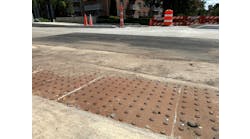Once again, I missed more than I got to experience, but nonetheless there was much of interest. (Side note: Two members of the ITSA board visited the Traffic & Transit booth and I told them directly my dissatisfaction and concern about the number of concurrent sessions, and they did listen, so here’s to hoping we’ll see a tweak in next year’s scheduling.)
A visit to the Miovision booth gave me a fine primer on the platform the company is employing right here on more than half of the intersections in Detroit. Miovision’s data accumulation and analysis system is in place in more than 100 agencies across the country, and in the Motor City, they are also working in conjunction with city leaders on the “World’s Smartest Intersection.” Aligned down Larned Street right in the heart of downtown, the multi-block corridor is advantaging existing physical infrastructure to generate workable and actionable data for city DOT operations engineers and traffic managers. According to VP of market strategy Dave Bullock, the aim and value of the company’s partnership is to both save lives and to aid, if not direct, city leaders in their decision-making process for where to put their always-limited transportation budget dollars. It’s all a bit much to process, but be sure to keep your eyes peeled for the Fall edition of Traffic & Transit magazine, which will feature an in-depth look at the advent of these intersections and the practical effect they are having on the city.
Late in the day, GRIDSMART held an invitation-only presentation concerning its new ITS-based training program. The crux of this program’s purpose is to directly address the lack of education in the existing workforce with regard to emerging and already existing ITS on public corridors. To wit: You’ve got the 30-year vet who goes out into the field to a steel box and cannot identify how a piece of smart traffic signal technology is inadequately set up. That’s a problem, one that is already common, and likely encountered at each DOT in the country; this is a legit concern. And of course it helps GRIDSMART brand-build for its own tech, but education within the industry is nonetheless the gorilla in the ITS room. Mobility and cybersecurity are commensurate concerns, as well.
It consists basically of a three step process; in its simplest form:
- Competency-based seminars;
- Learning is embedded into these live seminars; and
- The awarding of certified-professional certification.
It will be interesting to see how it develops, and how many agencies accept and adopt such a program. (You’ll see more about this in T&T soon.)
The technical and special sessions were again chock full of compelling presentations, including one focused on improving transportation system resiliency with connected vehicle data. The Florida DOT talked about how it leveraged various TSM&O tools—including emergency shoulder use, dynamic message signs, CCTV, Waze and Google, and INRIX and HERE data, among other sources—to track the movement of evacuee traffic in advance of Hurricane Irma (which I learned, interestingly, roughly followed the course of I-75 up through the state). Also, the Iowa DOT discussed the more than 370 roadside speed and volume sensors in place throughout the state. The state has centralized all ITS operations to a single traffic management center, which offers live corridor monitoring. The agency is also working with Iowa State University to make sense of all the data it is now capable of pulling together. The future for the Iowa DOT will include increasing the number of ITS placements in the state, in both urban and rural locales.
Finally, I dropped into the U.S. DOT summary session on its December 2017 roundtable on AV safety. It was by far the worst attended seminar I have attended thus far. Is it dubiousness toward federal interest in the safety aspects of AV data usage? Was it too close to cocktail hour? (GRIDSMART smartly provided a bar for its session.) One nugget of optimism came from Deputy Assistant Secretary for Transportation Policy Finch Fulton, who said, “Tomorrow’s efforts are now a dialogue. We are taking more action, and no longer just listening.” I’ll believe it when I see it (given how transpo funding is off the table for 2018), but would encourage everyone to take the federal government, in this score if no other, at its word.



